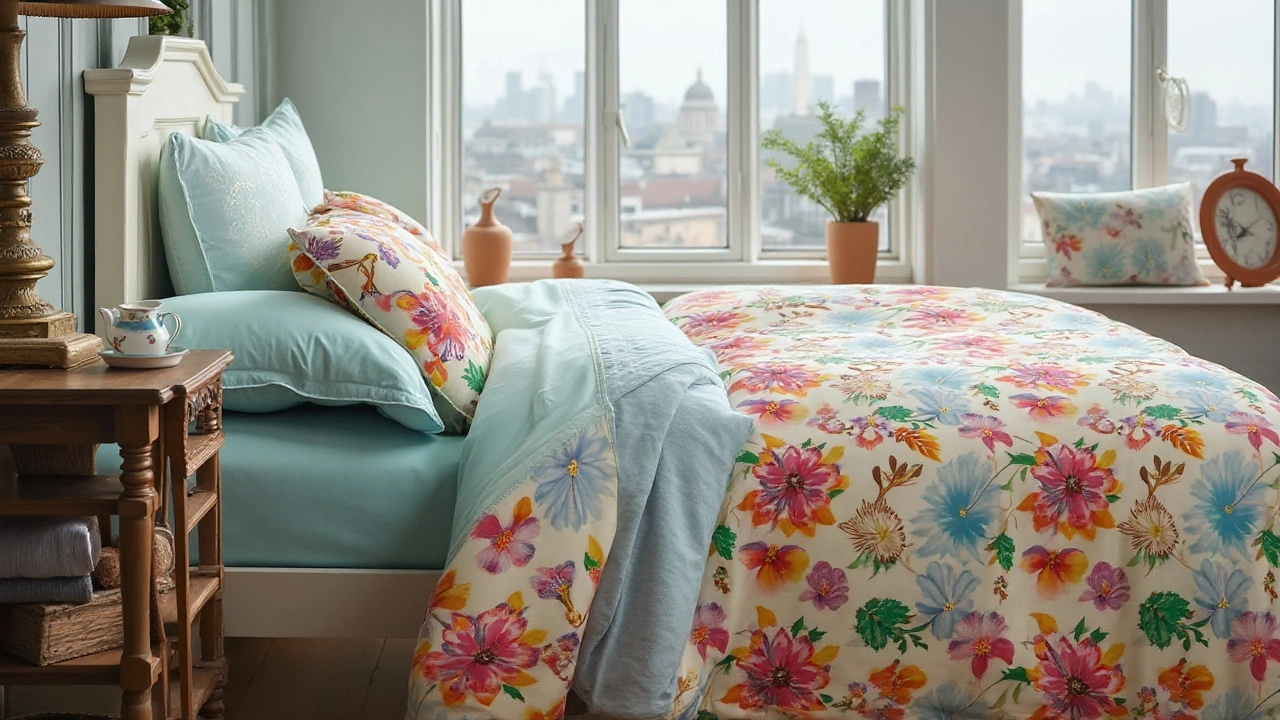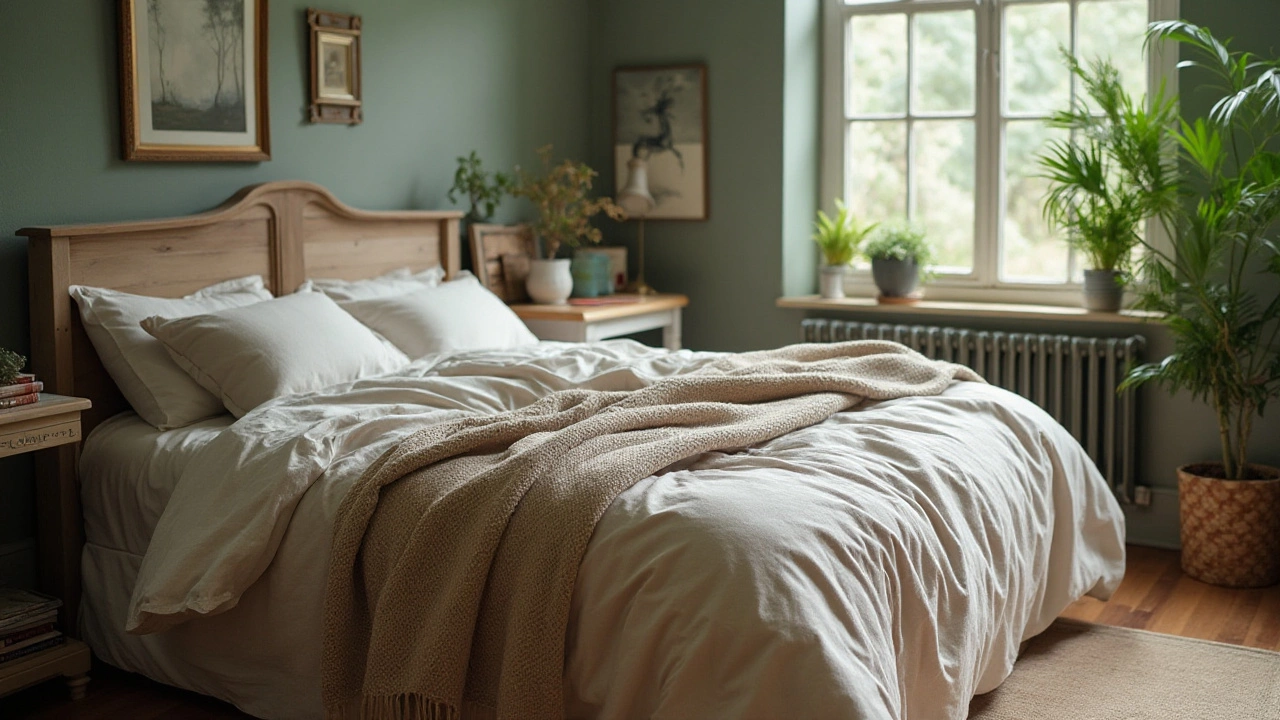Exploring Modern Bedding Slang and Trends

The world of bedding isn't just about comfort; it's also about expression, culture, and innovation. Over the years, the jargon used by enthusiasts and industry insiders has evolved, reflecting shifts in lifestyle and design. For those who may feel a little lost amidst this avalanche of new terms, fear not. This guide is here to unravel the mystery behind modern bedding slang.
As consumers become more conscious of quality and sustainability, the bedding industry has responded with an impressive array of options. It's not just about choosing cotton anymore; it's about understanding terms like 'thread count' and 'GOTS-certified,' and what they mean for your night's rest. Let's embark on a journey to understand these trends better and learn how to pick the perfect bedding for a restful night.
- Understanding Bedding Slang
- Popular Bedding Trends
- Materials Making a Difference
- Tips for Optimum Sleep Comfort
- Future Trends in Bedding
Understanding Bedding Slang
Dive into any discussion about bedding, and you're likely to encounter a variety of terms that might sound like a foreign language to the uninitiated. The rise of specialized stores and online platforms has accelerated the spread of these terms, many of which reflect broader cultural shifts in how we think about sleep and comfort. From ‘thread count’ to ‘OEKO-TEX certified,’ these phrases tell a story of innovation and heightened awareness.
Thread count, one of the more ubiquitous terms, signifies the number of threads woven into a square inch of fabric. Though often touted as an indicator of quality, it's not the sole factor to consider. Some fabrics, especially those made from Egyptian or Pima cotton, deliver luxurious comfort at even moderate thread counts. Then there's 'OEKO-TEX certified' bedding, which guarantees that dyes, fibers, and fabrications have been tested against harmful substances, catering to the environmentally-conscious consumer.
Emerging Trends in Bedding Language
Beyond these established terms, newer slang reflects contemporary priorities. Consider ‘microfiber,’ a synthetic material known for its softness and affordability. Though not as breathable as natural fibers, its ease of care appeals to fast-paced lifestyles. Another buzzword in the realm of bedding is ‘GOTS-certified,’ representing textiles that meet the stringent organic standards of the Global Organic Textile Standard. This certification is crucial for individuals looking to minimize their ecological footprint without compromising on comfort.
“Smart consumers today are seeking more than just a good night’s sleep; they want to rest easy knowing their choices are sustainable and conscious,” says Clara Humphrey, a textile industry analyst.
In today's marketplace, the importance of vocabulary extends into aesthetics as well. Styles such as ‘boho chic,’ with its eclectic layering, or ‘minimalist,’ with clean, uncluttered looks, speak directly to personal identities. They’re more than just styles; they're expressions of who we are. Getting acquainted with these terms is not merely about keeping pace with trends; it's about enhancing our living spaces to better reflect our unique lifestyles.
Myth-Busting and Practical Advice
Some terms can stir up misconceptions. Take 'hypoallergenic,' for instance. While it suggests resistance to allergens, no product can claim absolute protection. It's important to discern marketing hype from functional benefits. Look for materials naturally resistant to dust mites, like silk or tightly woven cotton, to enjoy real relief from allergies.
In essence, as you navigate the sea of modern bedding options, understanding the nuances in slang can enhance your decision-making process. It’s not just about hopping on the latest trends; it’s about finding what genuinely aligns with your comfort and lifestyle. Whether you choose an organic bamboo sheet set or a bold duvet cover reflecting your love for color, knowledge is your greatest asset in creating a sanctuary of rest.
Popular Bedding Trends
The bedding landscape is constantly evolving, responding to changing consumer preferences and the latest lifestyle shifts. One remarkable trend is the embrace of sustainable and eco-friendly bedding options. As the world becomes more environmentally conscious, consumers are increasingly looking for products that align with their values. This has brought materials like organic cotton and bamboo into the spotlight. These materials not only promise environmental friendliness but also offer incredible comfort and temperature regulation, ensuring a restful night's sleep.
Another trend catching on is the use of bold and unique colors, as well as patterns that reflect individuality and style. Gone are the days when neutral shades dominated bedroom aesthetics. Today's consumers are not shying away from using vibrant tones and playful prints to bring their bedding to life. This shift not only adds a touch of personality to the bedroom but also contributes to a more inviting and personalized space.
A quote from New York-based interior designer Jonathan Adler encapsulates this movement:
"Bedding should be anything but boring. Allow it to be a canvas for your creativity and expression. It's a functional piece of art."With such endorsements, it's no wonder that bedding is becoming a key component of interior design conversations.
Technological innovation in modern bedding has also been remarkable. Smart textiles embedded with sensors are gaining ground, aimed at tracking sleep patterns and offering insights into personal well-being. Products that integrate with apps to suggest the best sleep environments through lighting and temperature control are part of this innovative leap. These developments bring bedding into the tech-savvy world and ensure that users get the most optimized sleep experience possible.
The effect of global influences cannot be ignored. Scandinavian 'hygge' culture, emphasizing coziness and comfort, has led to increased popularity of plush, layered textiles that aim to provide warmth and tranquility. Simultaneously, Japanese 'zen' principles draw fans towards minimalist aesthetic bedding that offers simplicity and serenity. This fusion of global trends yields diverse options for consumers to escape into personally curated sanctuaries.
Let's not forget, performance-driven bedding items like cooling sheets and weighted blankets are enhancing sleep quality for many. Cooling sheets, often made from moisture-wicking materials, cater to those who tend to feel warm as they sleep, while weighted blankets provide comforting pressure that has been reported to reduce anxiety and promote deeper sleep. Their rise underscores an awareness and demand for functional products that address specific sleep concerns.
The bedding market is more dynamic than ever, reflecting changes in societal values and technological advancements. With these trends, there's a rich tapestry of options catering to every taste and functional need, making it an exciting time for bedding aficionados to explore and reinvent their sleep spaces with the latest trends in bedding.

Materials Making a Difference
In the ever-evolving universe of bedding, materials have started to take center stage as crucial factors that influence both comfort and sustainability. Consider the rise of eco-friendly sheets, for instance. These are often crafted from organic fibers like cotton and bamboo, known for their minimal environmental impact. Cotton, with its breathable quality, enhances comfort, but when organically produced, it also reduces harmful chemicals in our homes. On the other hand, bamboo fibers are celebrated not just for their sustainability, but also for their luxurious feel, offering a silky texture that many avid sleep enthusiasts prefer.
Another modern innovation in bedding materials is represented by Tencel. This fabric is made from the cellulose of eucalyptus trees, which themselves require less water and pesticides than traditional cotton crops. Tencel is praised for being soft, lightweight, and absorbent, drawing moisture away from the skin to keep sleepers cool and comfortable. As an added bonus, it resists wrinkles and creases, making it a practical choice for those who value both style and function. According to some textile experts, Tencel could be the 'next big thing' in the industry, offering a perfect blend of sustainability and comfort.
With numerous choices available, finding the right materials involves considering specific needs such as skin sensitivity, allergies, and temperature preferences. Wool, for example, might be overlooked by those wary of its association with thick, scratchy fabrics, yet modern wool bedding is surprisingly soft and effective at thermal regulation. Its breathability and moisture-wicking abilities make it a favorite for both warm and cold climates. Additionally, it is naturally resistant to dust mites, mold, and mildew, making it ideal for those suffering from allergies.
When examining these emerging materials, it's equally important to look at the production processes involved. Sustainable manufacturing practices are rising in priority for many brands, aimed at delivering high-quality products while minimizing harm to people and the planet. A noteworthy aspect of this shift can be observed in bedding products that feature the Global Organic Textile Standard (GOTS) certification. This designation ensures textiles meet rigorous criteria for ecological and social responsibility from harvest through production. Buying these certified products can provide peace of mind, knowing they align with higher standards of environmental and ethical stewardship.
The popularity of these materials is partly due to a growing consciousness about health and environmental impact. Sleep hygiene is increasingly recognized as pivotal to our well-being, prompting more consumers to seek out bedding options that contribute to a better night’s rest. Investing in high-quality materials can have a significant ripple effect, improving our rest while reducing our ecological footprint. As the bedding landscape continues to grow and adapt to consumer demands, new materials will undoubtedly emerge, promising even greater breakthroughs in sleep innovation.
Tips for Optimum Sleep Comfort
Getting a good night's sleep is essential for both physical and mental health, yet many struggle to achieve it consistently. Understanding the art of creating an ideal sleeping environment can transform your nights from restless to rejuvenating. A critical factor in optimizing sleep quality lies in the choice of bedding. Opt for natural materials like cotton, bamboo, or linen. These fibers allow breathability, reduce moisture, and provide a soothing touch. It's essential to select sheets with the right thread count—usually between 200-400—for a balance of softness and durability. Combine these with a supportive mattress tailored to your sleep position and preference—whether firm, soft, or somewhere in between. A comfortable mattress can significantly impact the quality of your rest, aligning your spine and helping to reduce pressure points during sleep.
Temperature regulation is another crucial element in crafting the perfect sleep setting. Experts frequently suggest keeping your room cool, around 60 to 67 degrees Fahrenheit, which helps your body's natural drop in temperature as you drift off to sleep. Investing in a set of temperature-regulating bedsheets or using a light blanket during warmer months can also aid in maintaining this ideal environment. To offer additional comfort, many people layer their bedding, using a duvet cover over a lighter bedspread, offering the flexibility to adjust warmth according to their needs. Keeping sleep-friendly materials in mind, think about investing in hypoallergenic options if allergies or skin sensitivities present a problem, as these can prevent irritation and interrupted sleep.
"Sleep is the best meditation." — Dalai Lama
The element of a calming ambiance cannot be underestimated. Consider the aesthetics and serenity of your sleeping space. A clutter-free, harmonious setting can help unwind and de-stress your mind before drifting away. Soft, muted colors are commonly recommended, as they promote relaxation and calmness. Introduce gentle lighting with dimmable lamps and consider blackout curtains if external light proves disruptive. Incorporating plants into your bedroom can offer a natural air filtration effect and introduce tranquility into your space. Aromatherapy is another technique to foster a calm atmosphere. Scents like lavender or chamomile, renowned for their relaxing qualities, can be introduced via essential oils or linen sprays. This sensory dimension can help signal your brain that it's time to unwind and prepare for rest.
When considering modern bedding trends, you'll see growth in tech-driven solutions that cater to sleep optimization. Smart bedding can adjust temperatures, track sleep cycles, and even provide gentle vibrational alarms to wake us during light sleep stages. For those who prefer traditional methods, the simplicity of sleep masks and earplugs continues to be effective for blocking distractions. Remember, achieving optimal sleep isn’t just about bedding; it includes creating a routine that encourages consistent sleep. Aim to establish a regular sleep schedule, winding down with activities like reading or meditative reflection, which create a consistent sleep-wake cycle.
Consumers are also paying attention to the sustainability of their bedding choices, a factor that adds layers of comfort to a purchase. Opting for GOTS-certified organic bedding, for instance, not only assures quality but echoes a commitment to environmentally-friendly practices. Such choices reflect the sensibilities of a more informed and conscientious generation, blending the quest for a night's perfect rest with ethical decisions impacting our planet. Recent studies have shown that sustainable bedroom decor can boost not only sleep quality but also mood and well-being, as individuals feel more connected to their values in daily experiences. Remember, investing in the right bedding is investing in your health, supporting the foundation of waking up refreshed and ready to seize the day.

Future Trends in Bedding
As we gaze into the horizon of what lies ahead in the realm of bedding trends, it's evident that innovation and sustainability are taking center stage. We're living in an age where the focus isn't merely on aesthetics and comfort; people are increasingly concerned with the environmental footprint of the products they choose. Emerging materials like hemp and bamboo are gaining attention due to their eco-friendly credentials, boasting natural antibacterial properties and a lower water footprint compared to traditional cotton. The shift towards greener materials isn't just a passing wave but a profound movement that reshapes how consumers perceive luxury and sustainability in modern bedding.
Smart technology is also weaving its way into our bedrooms, and this includes bedding. Imagine sheets and blankets equipped with sensors to adjust the temperature or firmness according to individual preferences. Technology like this is not science fiction but an evolving reality, creating a new market for tech-integrated bedding that adapts to our body's needs for a more restful sleep. According to the Sleep Foundation, a good night's sleep significantly improves mental and physical health, thus creating a ripe environment for continued innovation in smart bedding technologies.
Bedding slang is evolving too, reflecting these advancements. Terms like 'temperature-regulating', 'hypoallergenic', and 'sustainably sourced' are becoming household lexicons, embedded in the consumer consciousness as indicators of quality and responsibility. As consumers become more discerning, companies are innovating to meet these expectations, with some brands even offering subscription services for bedding, allowing consumers to refresh their bed duds more frequently without the high upfront costs.
"The future of bedding is about enhancing wellbeing while minimizing impact," stated an industry leader from the Sustainable Furnishings Council. "We're witnessing a paradigm shift where ecological responsibility meets user-centered design."
Moreover, the concept of sleep personalization is gaining momentum. Future trends are likely to include even more bespoke options as companies leverage AI and machine learning to create highly personalized sleep environments. From determining the ideal firmness of your mattress to the perfect mix of materials that suit individual allergic sensitivities, the possibilities are extensive. Bedding trends are clearly headed towards a more personalized future, taking into account personal preferences and health needs, alongside aesthetic appeal.
A recent market research report by Statista shows a projected increase of 3.8% annually in the bedding industry by 2030, highlighting the significant role of innovation in driving industry growth. This data illustrates that while traditional bedding staples remain, there's a marked shift towards embracing these future-forward trends. With an ever-growing emphasis on quality sleep and sustainable living, the bedding industry is poised to become a pivotal player in home lifestyle advances. The horizon certainly looks promising for those eager to embrace this blend of luxury, sustainability, and technology in their sleep sanctuaries.